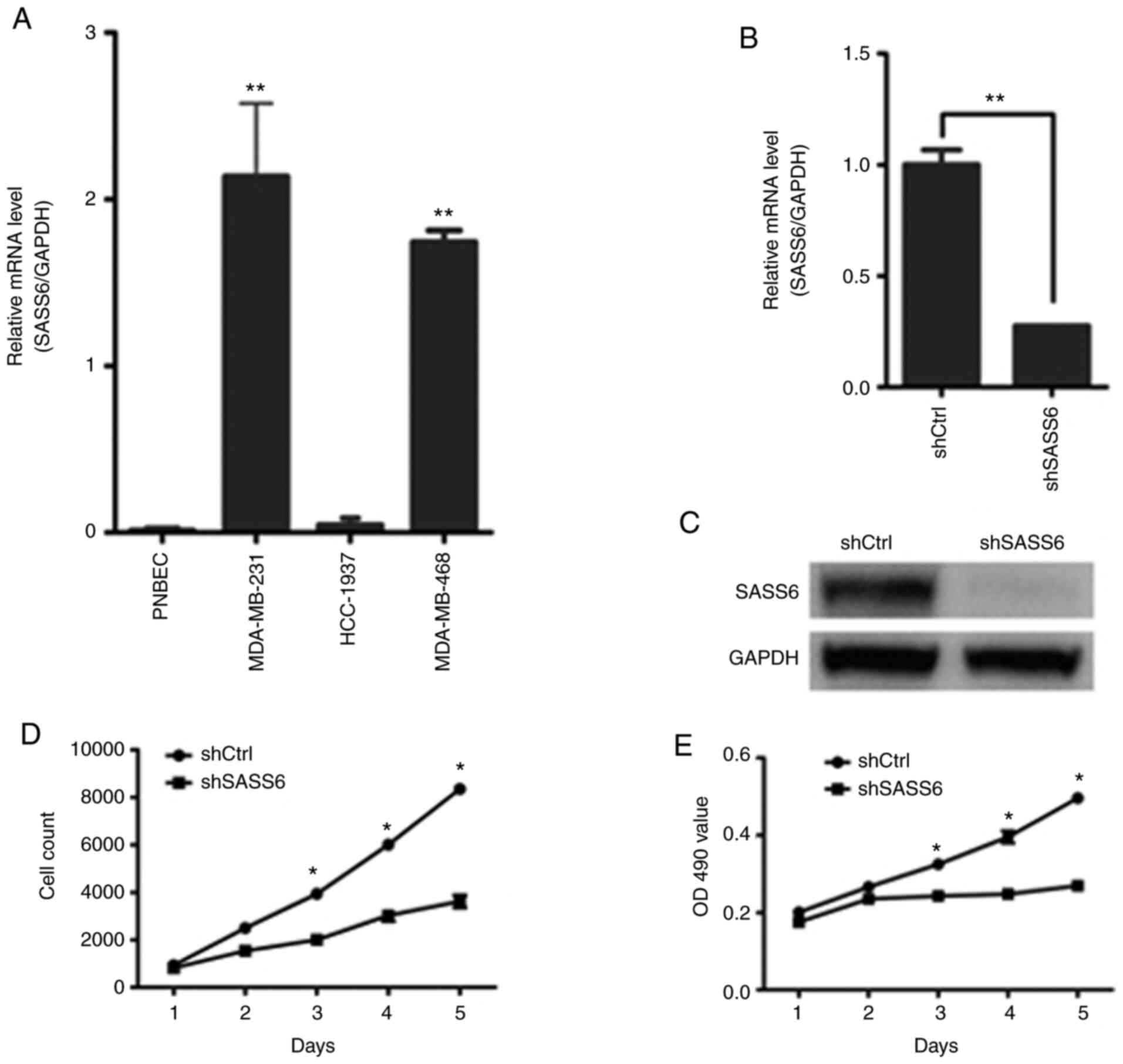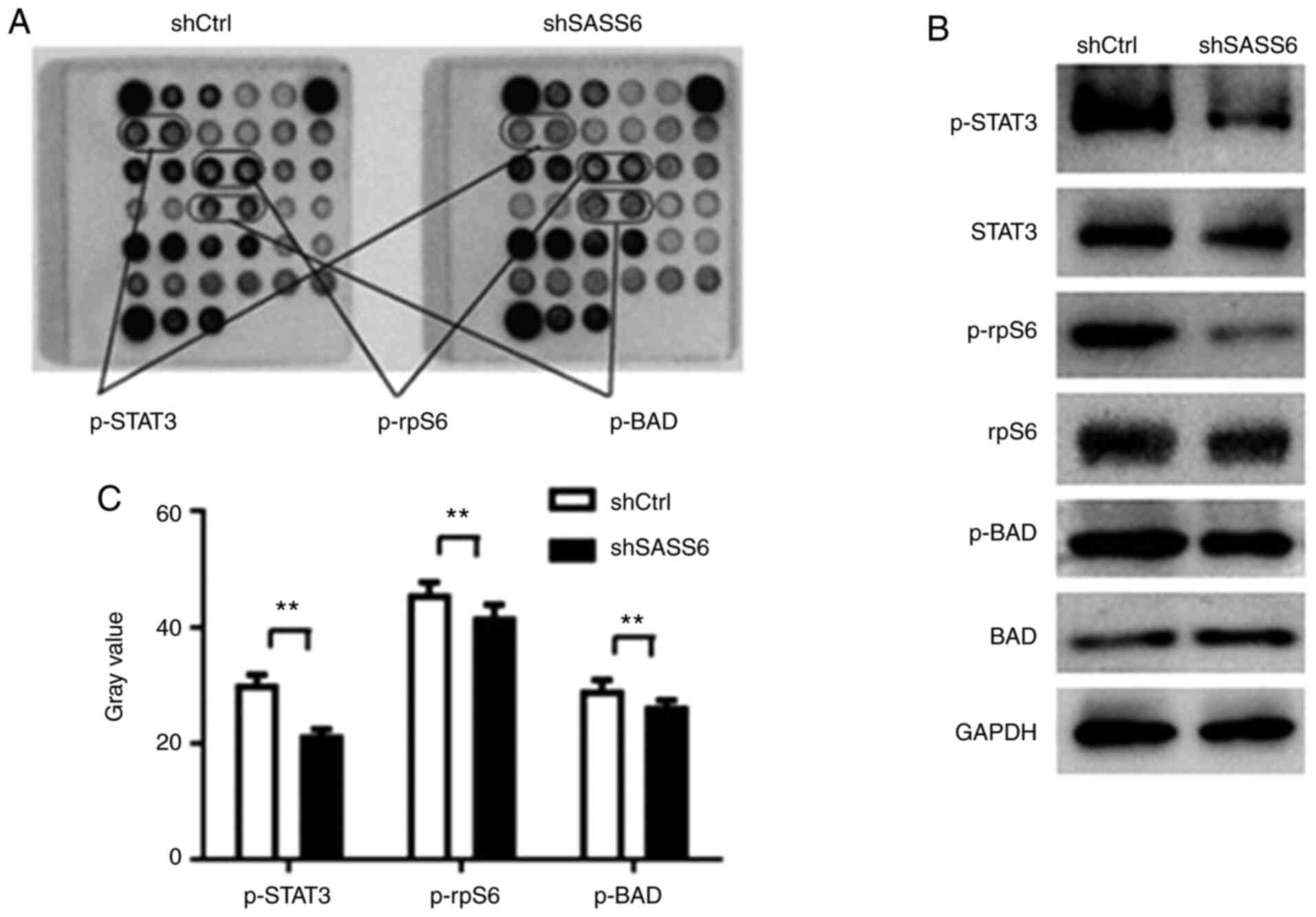|
1
|
Sharma P: Update on the treatment of
early-stage triple-negative breast cancer. Curr Treat Options
Oncol. 19:222018. View Article : Google Scholar : PubMed/NCBI
|
|
2
|
De Laurentiis M, Cianniello D, Caputo R,
Stanzione B, Arpino G, Cinieri S, Lorusso V and De Placido S:
Treatment of triple negative breast cancer (TNBC): Current options
and future perspectives. Cancer Treat Rev. 36 (Suppl 3):S80–S86.
2010. View Article : Google Scholar
|
|
3
|
Rivera-Rivera Y and Saavedra HI:
Centrosome-a promising anti-cancer target. Biologics. 10:167–176.
2016.PubMed/NCBI
|
|
4
|
Raff JW: Centrosomes and cancer: Lessons
from a TACC. Trends Cell Biol. 12:222–225. 2002. View Article : Google Scholar : PubMed/NCBI
|
|
5
|
Salisbury JL: The contribution of
epigenetic changes to abnormal centrosomes and genomic instability
in breast cancer. J Mammary Gland Biol Neoplasia. 6:203–212. 2001.
View Article : Google Scholar : PubMed/NCBI
|
|
6
|
Korzeniewski N, Hohenfellner M and
Duensing S: The centrosome as potential target for cancer therapy
and prevention. Expert Opin Ther Targets. 17:43–52. 2013.
View Article : Google Scholar : PubMed/NCBI
|
|
7
|
Chan JY: A clinical overview of centrosome
amplification in human cancers. Int J Biol Sci. 7:1122–1144. 2011.
View Article : Google Scholar : PubMed/NCBI
|
|
8
|
Pihan GA, Purohit A, Wallace J, Knecht H,
Woda B, Quesenberry P and Doxsey SJ: Centrosome defects and genetic
instability in malignant tumors. Cancer Res. 58:3974–3985.
1998.PubMed/NCBI
|
|
9
|
Leidel S, Delattre M, Cerutti L, Baumer K
and Gönczy P: SAS-6 defines a protein family required for
centrosome duplication in C. elegans and in human cells. Nat Cell
Biol. 7:115–125. 2005. View
Article : Google Scholar : PubMed/NCBI
|
|
10
|
Yoshiba S, Tsuchiya Y, Ohta M, Gupta A,
Shiratsuchi G, Nozaki Y, Ashikawa T, Fujiwara T, Natsume T,
Kanemaki MT and Kitagawa D: HsSAS-6-dependent cartwheel assembly
ensures stabilization of centriole intermediates. J Cell Sci.
132:jcs2175212019. View Article : Google Scholar : PubMed/NCBI
|
|
11
|
Strnad P, Leidel S, Vinogradova T,
Euteneuer U, Khodjakov A and Gönczy P: Regulated HsSAS-6 levels
ensure formation of a single procentriole per centriole during the
centrosome duplication cycle. Dev Cell. 13:203–213. 2007.
View Article : Google Scholar : PubMed/NCBI
|
|
12
|
Shinmura K, Kato H, Kawanishi Y, Nagura K,
Kamo T, Okubo Y, Inoue Y, Kurabe N, Du C, Iwaizumi M, et al: SASS6
overexpression is associated with mitotic chromosomal abnormalities
and a poor prognosis in patients with colorectal cancer. Oncol Rep.
34:727–38. 2015. View Article : Google Scholar : PubMed/NCBI
|
|
13
|
Annika W, Anja MB, Kereshmeh T, Justus PB,
Paul DD, Michael S, Raymund EH, Matthias WB, Pamela LS and Reiner
S: Selective isolation and characterization of primary cells from
normal breast and tumors reveal plasticity of adipose derived stem
cells. Breast Cancer Res. 18:322016. View Article : Google Scholar
|
|
14
|
Livak KJ and Schmittgen TD: Analysis of
relative gene expression data using real-time quantitative PCR and
the 2(-Delta Delta C(T)) method. Methods. 25:402–408. 2001.
View Article : Google Scholar : PubMed/NCBI
|
|
15
|
Borsotti C, Borroni E and Follenzi A:
Lentiviral vector interactions with the host cell. Curr Opin Virol.
21:102–108. 2016. View Article : Google Scholar : PubMed/NCBI
|
|
16
|
Zha J, Harada H, Osipov K, Jockel J,
Waksman G and Korsmeyer SJ: BH3 domain of BAD is required for
heterodimerization with BCL-XL and pro-apoptotic activity. J Biol
Chem. 26(272): 24101–24104. 1997. View Article : Google Scholar
|
|
17
|
Comartin D, Gupta GD, Fussner E, Coyaud É,
hasegan M, Archinti M, Cheung SW, Pinchev D, Lawo S, Raught B, et
al: CEP120 and SPICE1 cooperate with CPAP in centriole elongation.
Curr Biol. 23:1360–1366. 2013. View Article : Google Scholar : PubMed/NCBI
|
|
18
|
Xu X, Huang S, Zhang B, Huang F, Chi W, Fu
J, Wang G, Li S, Jiang Q and Zhang C: DNA replication licensing
factor Cdc6 and Plk4 kinase antagonistically regulate centrosome
duplication via Sas-6. Nat Commun. 8:151642017. View Article : Google Scholar : PubMed/NCBI
|
|
19
|
Arquint C, Sonnen KF, Stierhof YD and Nigg
EA: Cell-cycle-regulated expression of STIL controls centriole
number in human cells. J Cell Sci. 125:1342–1352. 2012. View Article : Google Scholar : PubMed/NCBI
|
|
20
|
Lin YC, Chang CW, Hsu WB, Tang CJ, Lin YN,
Chou EJ, Wu CT and Tang TK: Human microcephaly protein CEP135 binds
to hSAS-6 and CPAP, and is required for centriole assembly. EMOJ.
32:1141–1154. 2013.
|
|
21
|
Puklowski A, Homsi Y, Keller D, May M,
Chauhan S, Kossatz U, Grünwald V, Kubicka S, Pich A, Manns MP, et
al: The SCF-FBXW5 E3-ubiquitin ligase is regulated by PLK4 and
targets HsSAS-6 to control centrosome duplication. Nat Cell Biol.
13:1004–1009. 2011. View
Article : Google Scholar : PubMed/NCBI
|
|
22
|
Keller D, Orpinell M, Olivier N, Wachsmuth
M, Mahen R, Wyss R, Hachet V, Ellenberg J, Manley S and Gönczy P:
Mechanisms of HsSAS-6 assembly promoing centriole formation in
human cells. J Cell Biol. 204:697–712. 2014. View Article : Google Scholar : PubMed/NCBI
|
|
23
|
Johnson A and O'Donnell M: Cellular DNA
replicases: Components and dynamics at the replication fork. Annu.
Rev. Biochem. 74:283–315. 2005.
|
|
24
|
Bromberg JF, Wrzeszcznska MH, Devgan G,
Zhao Y, Pestell RG, Albanese C and Darnell JE Jr: Stat3 as an
oncogene. Cell. 98:295–303. 1999. View Article : Google Scholar : PubMed/NCBI
|
|
25
|
William MB, Jin XH, Lin HJ, Huang M, Liu
R, Reynolds RK and Lin J: Inhibition of constitutively active Stat3
suppresses growth of human ovarian and breast cancer cells.
Oncogene. 20:7925–7934. 2001. View Article : Google Scholar
|
|
26
|
Catlett-Falcone R, Landowski T, Oshiro M,
Turkson J, Levitzki A, Savino R, Ciliberto G, Moscinski L,
Fernández-Luna JL, Nuñez G, et al: Constitutive activation of Stat3
signaling confers resistance to apoptosis in human U266 myeloma
cells. Immunity. 10:105–115. 1999. View Article : Google Scholar : PubMed/NCBI
|
|
27
|
Shen Y, Devgan G, Darnell JE Jr and
Bromberg JF: Constitutively activated Stat3 protects fibroblasts
from serum withdrawal and UV induced apoptosis and antagonizes the
proapoptotic effects of activated Stat1. Proc Natl Acad Sci USA.
98:1543–1548. 2001. View Article : Google Scholar : PubMed/NCBI
|
|
28
|
Garcia R, Yu CL, Hudnall A, Catlett R,
Nelson KL, Smithgall T, Fujita DJ, Ethier SP and Jove R:
Constitutive activation of Stat3 in fibroblasts transformed by
diverseoncoproteins and in breast carcinoma cells. Cell Growth
Differ. 8:1267–1276. 1997.PubMed/NCBI
|
|
29
|
Roshan S, Liu YY, Banafa A, Chen HJ, li
KX, Yang GX, He GY and Chen MJ: Fucoidan induces apoptosis of HepG2
cells by down-regulating p-Stat3. J Huazhong Univ Sci Technolog Med
Sci. 34:330–336. 2014. View Article : Google Scholar : PubMed/NCBI
|
|
30
|
Roux PP, Shahbazian D, Vu H, Holz MK,
Cohen MS, Taunton J, Sonenberg N and Blenis J: RAS/ERK signaling
promotes site-specific ribosomal protein S6 phosphorylation via RSK
and stimulates cap-dependent translation. J Biol Chem.
282:14056–14064. 2007. View Article : Google Scholar : PubMed/NCBI
|
|
31
|
Meyuhas O: Ribosomal protein S6
phosphorylation: Four decades of research. Int Rev Cell Mol Biol.
320:41–73. 2015. View Article : Google Scholar : PubMed/NCBI
|
|
32
|
Akar U, Ozpolat B, Mehta K,
Lopez-Berestein G, Zhang D, Ueno NT, Hortobagyi GN and Arun B:
Targeting p70S6K prevented lung metastasis in a breast cancer
xenograft model. Mol Cancer Ther. 9:1180–1187. 2010. View Article : Google Scholar : PubMed/NCBI
|
|
33
|
Zha J, Harada H, Yang E, Jockel J and
Korsmeyer SJ: Serine phosphorylation of death agonist BAD in
response to survival factor results in binding to 14-3-3 not
BCL-X(L). Cell. 87:619–628. 1996. View Article : Google Scholar : PubMed/NCBI
|
|
34
|
Yang E, Zha J, Jockel J, Boise LH,
Thompson CB and Korsmeyer SJ: Bad, a heterodimeric partner for
Bcl-XL and Bcl-2, displaces Bax and promotes cell death. Cell.
80:285–291. 1995. View Article : Google Scholar : PubMed/NCBI
|
|
35
|
Wei MC, Zong WX, Cheng EH, Lindsten T,
Panoutsakopoulou V, Ross AJ, Roth KA, MacGregor GR, Thompson CB and
Korsmeyer SJ: Proapoptotic BAX and BAK: A requisite gateway to
mitochondrial dysfunction and death. Science. 292:727–730. 2001.
View Article : Google Scholar : PubMed/NCBI
|















